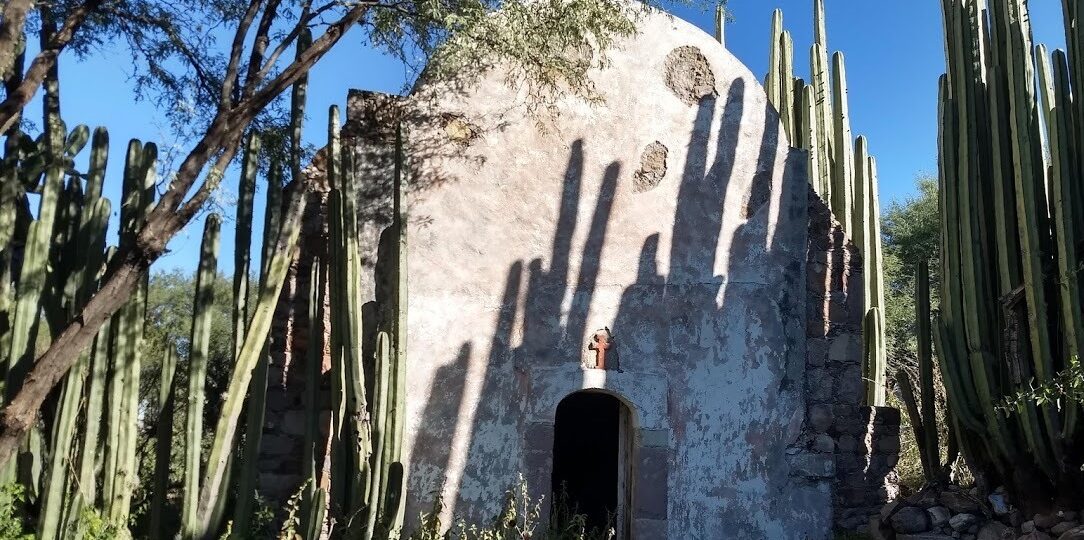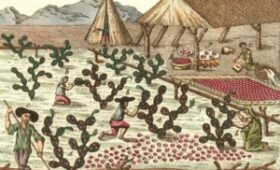There is the old adage that the best place to hide is often in plain sight. This certainly holds true for some of the most ancient chapels in San Miguel de Allende. There are several chapels from the 1700s that are tiny jewels in the San Miguel de Allende crown.
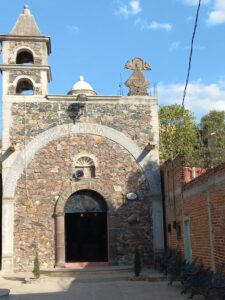 The most active of these chapels is dedicated to the Lord of the Conquest behind some foot traffic-only streets by the bus station. Here I’ve danced for celebrations with danzon buddies and watched both the
The most active of these chapels is dedicated to the Lord of the Conquest behind some foot traffic-only streets by the bus station. Here I’ve danced for celebrations with danzon buddies and watched both the 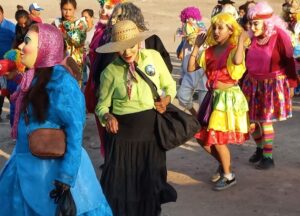 indigenous and Locos go by in many processions.
indigenous and Locos go by in many processions.
One of the most interesting architectural elements to the chapel are the seraphim. Seraphim are the highest level of angels that do nothing but sing all day. Hence, in art, they are just heads. Often they adorn columns but here the angels are at the base of columns.
The most historically significant and best preserved award goes to the small chapel along the old Silver Route outside of Palo Colorado popularly known as La Mesita (the little table). I’m sure it was once named for a saint or version of Mary no one seem to recall anymore.
The Sacred Cross is another likely name for this chapel as one of the top three most common chapel names in the area. The other most common names are The Virgin of Solitude (patroness of weavers that worked in the area) and Saint Isadore (patron of farmers that also worked here).
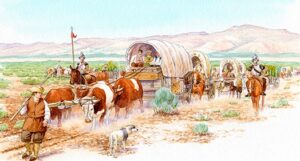 You can clearly see where wagon trains would pull over and rest for the night before the arduous eight hour trek into San Miguel the next day while dodging attacks by the indigenous Chichimecas. Today the trip is possible, by car, in about 20 minutes with nary an arrow lobbed in your direction.
You can clearly see where wagon trains would pull over and rest for the night before the arduous eight hour trek into San Miguel the next day while dodging attacks by the indigenous Chichimecas. Today the trip is possible, by car, in about 20 minutes with nary an arrow lobbed in your direction.
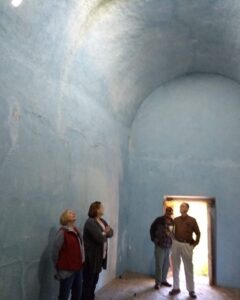 For years I toured this tiny and well preserved chapel until a new owner fenced in the property. I would not be surprised to soon see it is turned into destination wedding site. The chapel is absent of any art and furniture it once had and feels like being upside down in a pool devoid of water.
For years I toured this tiny and well preserved chapel until a new owner fenced in the property. I would not be surprised to soon see it is turned into destination wedding site. The chapel is absent of any art and furniture it once had and feels like being upside down in a pool devoid of water.
Following a war in the 1920s the Church owns the inside of a church or chapel (small church) while the government owns the outside. If the Church is no longer saying mass at the chapel they don’t care about it. If the Church doesn’t care the Mexican government isn’t going to maintain the building. At this point whoever owns the land around it can let the building become a ruin, pool house, storage shed, whatever.
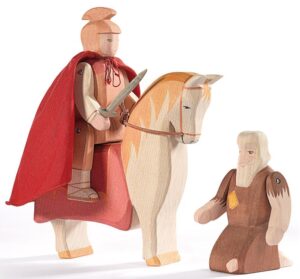 The word chapel started with St. Martin. You see his image in convenience stores around town as the gladiator cutting his cape in half to give a nude, elderly man on the ground. That night Martin dreamt the older man was Jesus causing him to change his life and become a priest. Martin kept his half of the cape to show folks that he had to go back to his military unit with his uniform and God doesn’t ask for more than we can do.
The word chapel started with St. Martin. You see his image in convenience stores around town as the gladiator cutting his cape in half to give a nude, elderly man on the ground. That night Martin dreamt the older man was Jesus causing him to change his life and become a priest. Martin kept his half of the cape to show folks that he had to go back to his military unit with his uniform and God doesn’t ask for more than we can do.
When Martin died his half of the cape had a small church in Rome built around it with the Latin word for cape being chapel. Today Martin is the patron saint of cowboys and those that rely on the kindness of strangers, like store owners waiting for a stranger to come in for a soda or chips. Thousands of cowboys and cowgirls trot though town near his feast day to have their horses blessed at the village called St. Martin.
Off the zig-zagging walking street of Cruz de Puebla are two ancient chapels no longer in use. One is reachable for a peek in.
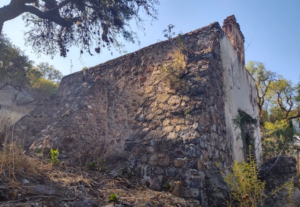 The chapel door is often ajar though largely blocked by piles of lumber stored there. You can peek around the door to see what appear to be indigenous frescoes in the distance. However,
The chapel door is often ajar though largely blocked by piles of lumber stored there. You can peek around the door to see what appear to be indigenous frescoes in the distance. However, 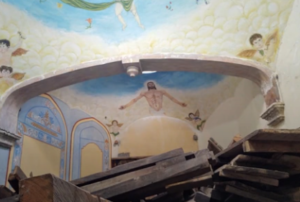 someone in the late 1960s or early 1970s, appears to have gotten really stoned and painted Jesus and some angels whose physiques and hair styles would seamlessly fit in on the Partridge Family bus.
someone in the late 1960s or early 1970s, appears to have gotten really stoned and painted Jesus and some angels whose physiques and hair styles would seamlessly fit in on the Partridge Family bus.
The other chapel is only visible by drone sitting just a few feet away.
On Cinco de Mayo is the more modern chapel to the Three Kings. The original Three Kings chapel is now in ruins sitting in the midst of the development, La Capilla de Piedra, named in 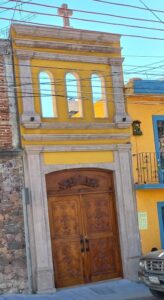 honor of the ruins. The more modern Three Kings chapel, when closed, is indistinguishable from other buildings on this busy street.
honor of the ruins. The more modern Three Kings chapel, when closed, is indistinguishable from other buildings on this busy street.
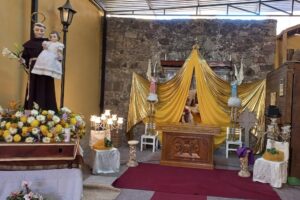 When open a long driveway leads up to the front of the chapel. The narrow driveway has chairs and an altar to say mass in as the actual chapel is quite tiny. A local lawyer focused on maintaining the chapel in the late 20th century and today Mary Cruz Gonzalez continues the preservation mission.
When open a long driveway leads up to the front of the chapel. The narrow driveway has chairs and an altar to say mass in as the actual chapel is quite tiny. A local lawyer focused on maintaining the chapel in the late 20th century and today Mary Cruz Gonzalez continues the preservation mission.
The chapel is rarely open outside of the Epiphany (Three Kings Day/January 6th) to allow the kings to distribute toys to local children. Year-long a nativity set is displayed with some unusual attendees including Guadalupe and an image of Mary in mourning. 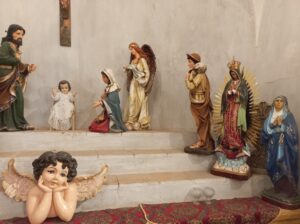 All the art is modern and only Heaven knows what happened to the original art featured.
All the art is modern and only Heaven knows what happened to the original art featured.
At one point all these chapels were for the far-flung from centro indigenous to have a place to worship the new religion the Spaniards brought across the pond along with horses, small pox and gunpowder.
